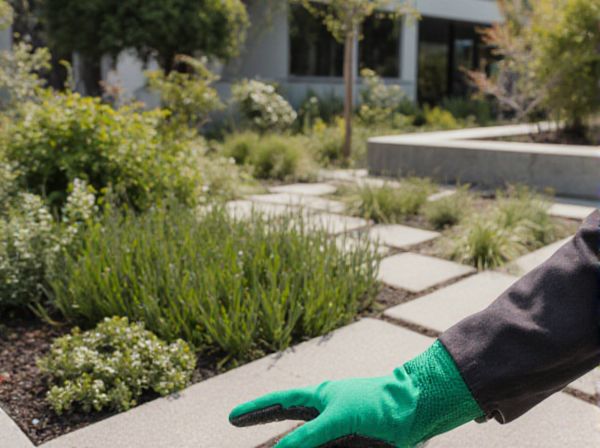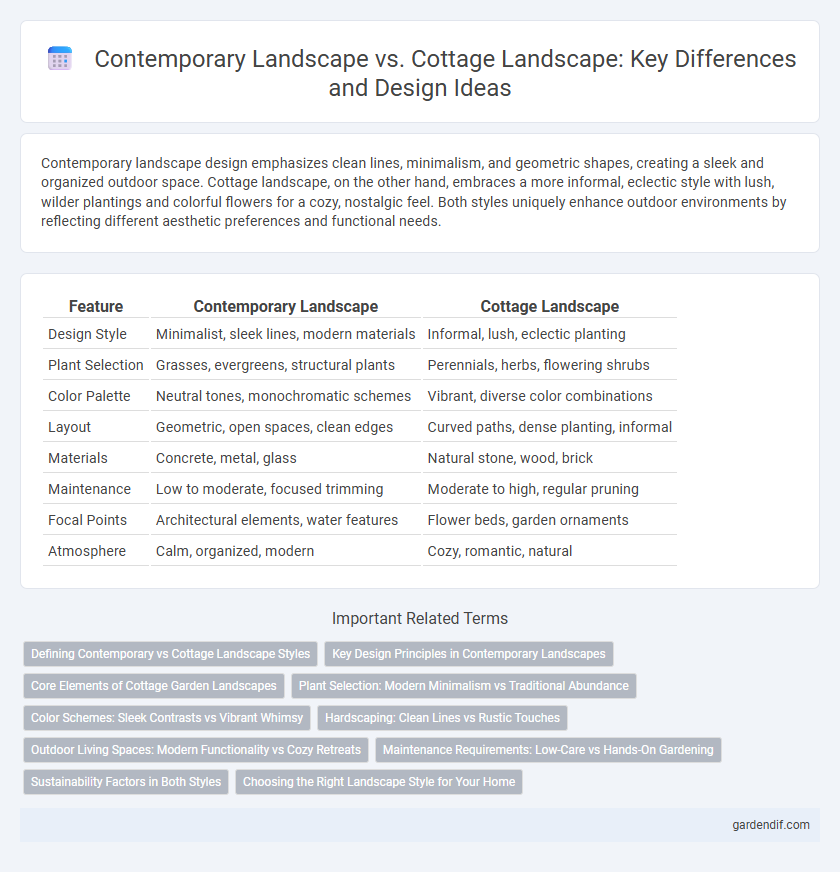
Contemporary Landscape vs Cottage Landscape Illustration
Contemporary landscape design emphasizes clean lines, minimalism, and geometric shapes, creating a sleek and organized outdoor space. Cottage landscape, on the other hand, embraces a more informal, eclectic style with lush, wilder plantings and colorful flowers for a cozy, nostalgic feel. Both styles uniquely enhance outdoor environments by reflecting different aesthetic preferences and functional needs.
Table of Comparison
| Feature | Contemporary Landscape | Cottage Landscape |
|---|---|---|
| Design Style | Minimalist, sleek lines, modern materials | Informal, lush, eclectic planting |
| Plant Selection | Grasses, evergreens, structural plants | Perennials, herbs, flowering shrubs |
| Color Palette | Neutral tones, monochromatic schemes | Vibrant, diverse color combinations |
| Layout | Geometric, open spaces, clean edges | Curved paths, dense planting, informal |
| Materials | Concrete, metal, glass | Natural stone, wood, brick |
| Maintenance | Low to moderate, focused trimming | Moderate to high, regular pruning |
| Focal Points | Architectural elements, water features | Flower beds, garden ornaments |
| Atmosphere | Calm, organized, modern | Cozy, romantic, natural |
Defining Contemporary vs Cottage Landscape Styles
Contemporary landscape style emphasizes clean lines, minimalistic design, and the use of modern materials like concrete, steel, and glass to create sleek, functional outdoor spaces. Cottage landscape style features a more relaxed, informal aesthetic with lush, colorful plantings, natural materials like wood and stone, and a charming, whimsical arrangement that evokes a cozy, lived-in feel. The contemporary approach prioritizes simplicity and structure, whereas the cottage style celebrates abundance and organic, asymmetrical layouts.
Key Design Principles in Contemporary Landscapes
Contemporary landscapes emphasize clean lines, minimalism, and functional spaces, prioritizing geometric shapes and open layouts that contrast with the informal, eclectic mix found in cottage landscapes. Key design principles include the use of sustainable materials, native plants, and water-efficient irrigation systems to create environmentally responsible outdoor areas. Integration of modern lighting and sculptural elements enhances the aesthetic appeal while supporting usability and low maintenance requirements.
Core Elements of Cottage Garden Landscapes
Cottage garden landscapes emphasize a natural, informal design featuring dense, colorful plantings of perennials, herbs, and flowering shrubs that create a charming, whimsical atmosphere. Core elements include winding paths, mixed borders, and rustic structures like wooden fences or arbors that enhance the garden's cozy, inviting feel. Unlike contemporary landscapes which favor clean lines and minimalism, cottage gardens prioritize layered textures and a harmonious blend of plants to evoke a sense of nostalgia and organic beauty.
Plant Selection: Modern Minimalism vs Traditional Abundance
Contemporary landscapes emphasize plant selection with modern minimalism, featuring sleek, structured greenery like ornamental grasses, succulents, and monochromatic foliage to create clean lines and open spaces. In contrast, cottage landscapes prioritize traditional abundance, showcasing a diverse mix of flowering perennials, herbs, and shrubs that foster a lush, informal, and layered garden environment. The choice between minimalist plant palettes and dense, colorful variety distinctly defines the character and maintenance of each landscape style.
Color Schemes: Sleek Contrasts vs Vibrant Whimsy
Contemporary landscapes emphasize sleek contrasts with monochromatic or limited color palettes often featuring greens, greys, and whites to create a modern, minimalist aesthetic. In contrast, cottage landscapes embrace vibrant whimsy through a diverse mix of bright, saturated colors including reds, pinks, yellows, and purples, fostering a playful, inviting atmosphere. This distinction in color schemes defines the clean, structured feel of contemporary gardens versus the eclectic, lush charm of cottage gardens.
Hardscaping: Clean Lines vs Rustic Touches
Contemporary landscapes emphasize hardscaping with clean lines, geometric shapes, and smooth surfaces often using materials like concrete, steel, and polished stone to create a sleek, minimalist aesthetic. Cottage landscapes incorporate hardscaping with rustic touches, including natural stone, uneven pathways, and weathered wood that blend seamlessly with lush planting and informal garden layouts. The contrast between the two lies in the precise, structured design of contemporary hardscaping versus the organic, charming imperfections found in cottage-style garden features.
Outdoor Living Spaces: Modern Functionality vs Cozy Retreats
Contemporary landscapes emphasize sleek outdoor living spaces with clean lines, integrated technology, and multifunctional areas designed for entertainment and relaxation. Cottage landscapes prioritize cozy retreats featuring natural materials, lush plantings, and intimate seating areas that blend seamlessly with the surrounding garden. Both styles enhance outdoor living but cater to different lifestyles through modern functionality versus warm, inviting atmospheres.
Maintenance Requirements: Low-Care vs Hands-On Gardening
Contemporary landscapes emphasize low-care maintenance with drought-tolerant plants, clean lines, and minimalistic design elements that reduce the need for frequent watering and pruning. Cottage landscapes demand hands-on gardening, featuring dense, mixed plantings with seasonal flowering shrubs and perennials that require regular pruning, deadheading, and soil enrichment. Choosing between these styles depends on the gardener's availability and preference for maintenance intensity, balancing time investment with aesthetic goals.
Sustainability Factors in Both Styles
Contemporary landscapes emphasize sustainability through native plant selections, drip irrigation systems, and permeable hardscapes that reduce water runoff and energy consumption. Cottage landscapes support biodiversity by incorporating diverse flowering plants and organic mulch while prioritizing composting and minimal chemical usage to maintain soil health. Both styles integrate eco-friendly practices, but contemporary landscaping often leverages modern technology for resource efficiency, whereas cottage landscaping relies more on traditional, natural methods.
Choosing the Right Landscape Style for Your Home
Selecting the right landscape style depends on factors like architectural design, maintenance preferences, and desired ambiance. Contemporary landscapes emphasize clean lines, minimalistic plantings, and modern materials such as concrete and steel, ideal for urban or modern homes. Cottage landscapes feature dense, colorful plantings with a natural, informal design using flowering perennials and rustic elements, perfect for creating a cozy, inviting garden atmosphere.
Contemporary Landscape vs Cottage Landscape Infographic

 gardendif.com
gardendif.com